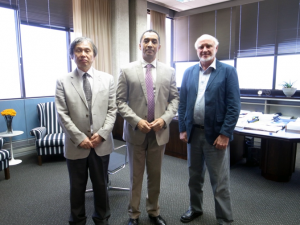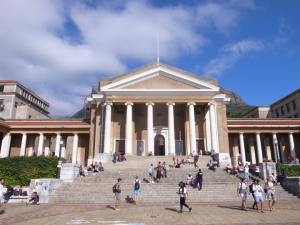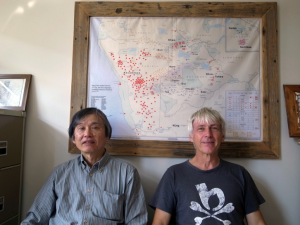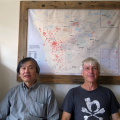
South Africa Report
On my visit to the University of Cape Town and Nelson Mandela Metropolitan University
Kyoto University
Specially Apointed Professor of The Center for African Area Studies
Shigeki Kaji
From 17 to 28 February 2016, I visited the cities of Cape Town and Port Elizabeth, South Africa. I arrived in Cape Town in the evening on 18 February after departing from Kansai Airport (KIX) on the night of the 17th aboard an Emirates flight, and connecting flight from Dubai. I was scheduled to visit Port Elizabeth first so at Cape Town I immediately boarded a South African Airways domestic flight to Port Elizabeth. The flight, however, was delayed because the Port Elizabeth airport was closed during the evening for a military operation, and my arrival was not until 21:00. I arrived 33 hours after leaving my home in Kyoto. At the airport Mr. Ernst Kotzé (professor emeritus Port Elizabeth University), a former ASAFAS visiting scholar, met me. Since my flight was originally scheduled to arrive at 20:00 he had arrived at the airport at 19:30, but found it closed and was unable to enter the facilities for some time.
In recent years, Port Elizabeth has merged with its surrounding districts and has been incorporated into the Nelson Mandela Bay Metropolitan Municipality. Its university name, Port Elizabeth University, has also been changed to the Nelson Mandela Metropolitan University. Of course “Nelson Mandela” refers to the late Nelson Mandela. The Eastern Cape Province, which includes Port Elizabeth, carries his legacy and for this reason his name has been adopted.
Port Elizabeth has an atmosphere quite different from cities like Nairobi and Kampala where I often visit. When one goes to the central districts of Nairobi or Kampala the majority of people seen there are black Africans, but in contrast this is not the situation in the city of Port Elizabeth. In addition, there are no high-rise buildings and in general the entire city is serene. There are fewer people in Port Elizabeth. And what is definitely the biggest difference is that Port Elizabeth is a city predominantly inhabited by white people. The city’s population is about 230 thousand and almost half of the people are Afrikaans-speaking whites. About 40% of the remaining people are English-speaking whites. So-called black Africans are few (at least in the head downtown) and are mostly members of the Xhosa people. In the suburban areas of the city one finds large residential housing complexes. Naturally, there are black African residents living in these houses.
The purpose of my visit to Nelsen Mandela Metropolitan University was to broaden the network of African area studies, which our project is aiming to create. The Nelsen Mandela Metropolitan University has several campuses and the main campus is located on a large piece of land in the southwest area of Port Elizabeth along the ocean coast. Inhabiting the campus land are wild animals such as zebras and baboons. The reason for this is that the campus land is located on part of an animal protection reserve. Although it is not likely that large animals wander in and out of the campus, I was told that it is not unusual to find baboons and monkeys outside the windows of faculty and staff offices.
Photo 1: Nelsen Mandela Metropolitan University.
Photo 2: In the Nelsen Mandela Metropolitan University Vice-Chancellor’s office. From left, myself, Vice-Chancellor Swartz and Dr. Kotzé.
On 22 February I met Prof. Derrick Swartz the university Vice-Chancellor. I was unable to catch the details of his specialization, but as the responsible of the university he showed interst in a wide range of scholarship. He knows much about Japan and told me he has opportunity to visit Japan almost every year. He has climbed Mt. Fuji. He is also well informed on Kyoto, being able to name in detail the various temples in Ohara, and is familiar with Japanese cuisine and kaiseki ryori. He met President Yamagiwa of our university last year.
Vice-Chancellor Swartz has a cheerful manner and is very amiable. He expressed his desire to open channels of exchange for students and researchers with Kyoto University. Dr. Kotzé had informed him that I conducted research in linguistics and African studies, and he is very keen to establish exchanges, not only with the humanities and social sciences, but also between our engineering, medical and oceanography faculties. Asked if President Yamagiwa had ever visited South Africa, I answered that he probably had not, and to this he replied that he definitely wished to invite him.
Including the day I arrived, my stay in Port Elizabeth lasted for 5 days, and it was a wonderful experience. Since the period of my visit was over a weekend, Dr. Kotzé and his wife took me to the Addo Elephant National Park on Sunday, 21 February. Although an elephant park, it being a national animal park proved also to be the habitat for numerous types of animals, such as, zebra, kudu antelope, buffalo and cheetah.
On 23 February, I traveled from Port Elizabeth to Cape Town. In contrast to the flat and level landscape of Port Elizabeth, Cape Town is a city of hills. It is also a much more bustling city filled with great activity. In addition to the large European population such as German and Italian, a big number of people from neighboring countries including Malawi and Zimbabwe give it a very cosmopolitan character. Another difference is the presence of “townships” scattered throughout the city. These may exist in Port Elizabeth as well, but I never saw any while I was there. In Cape Town, however, when traveling by car it is possible to see districts with poorly built houses densely packed together.
The University of Cape Town, where I visited, is said to be the highest-ranking university in Africa. There I met Dr. Matthias Brenzinger. Dr. Brenzinger is a German scholar, who is the director of the Centre for African Language Diversity, in the Faculty of Humanities. He is the counterpart of our program at the University of Cape Town. Since we are quite familiar with each other, negotiations concerning our liaison proceeded quite smoothly. He and Dr. Sheena Shah, a researcher in the Centre, are scheduled to visit our African Studies Center from 2 to 14 March 2016 to discuss concrete arrangements of the program and at the same time conduct their own personal research.
Photo 3: Library building of the University of Cape Town.
Photo 4: In Dr. Brenzinger’s office. The map on the wall shows the dispersion of the Khoisan languages.
In Cape Town I met another researcher, Dr. Wilfrid Haacke, who is a specialist of the Khoekhoe language. I have been acquainted with him since 1998. Recently, he retired from the University of Namibia and now lives in the north of Cape Town where his daughter lives. He is also acquainted with Dr. Takada, who is a member of our program. On the day before I left Cape Town, he and his wife came down to see me. He is now associated with Stellenbosch University where he continues his research.
My visit to South Africa was only for 9 days, but because I received much cooperation from many people things proceeded very smoothly and bore meaningful results. Our Brain Circulation Project has just begun. This trip has given me the assurance it will proceed quite satisfactorily as planned for the next two years.













